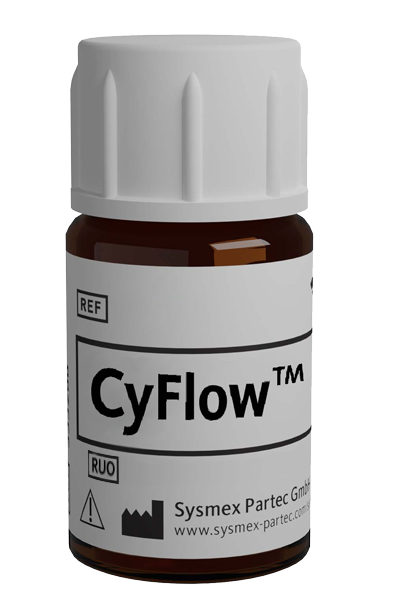CyFlow™ CD54 PE

| Alternative Name: | ICAM-1 |
| Antibody: | Yes |
| Antigen: | CD54 |
| Application: | Flow cytometry |
| Clonality: | monoclonal |
| Clone: | MEM-111 |
| Emission Maximum: | 576 nm |
| Excitation Maximum: | 496 nm, 565 nm |
| Field of Interest: | Immunophenotyping |
| Format/Fluorochrome: | PE |
| Isotype: | IgG2a |
| Laser: | Blue , Green, Yellow |
| Regulatory Status: | RUO |
| Source Species: | Mouse |
| Target Species: | Cow, Human, Rat |
| Product number: | AD327626 |
For Research Use Only
| HLDA Workshop | HLDA VI—WS Code AS A049 |
| Quantity | 100 tests |
| Volume | 2.0 mL |
| Immunogen | Raji cells: human Burkitt's lymphoma cell line |
| Background Information | CD54 (ICAM-1) is a 90 kD member of the C2 subset of immunoglobulin superfamily. It is a transmembrane molecule with 7 potential N-glycosylated sites, expressed on resting monocytes and endothelial cells and can be upregulated on many other cells, e.g. with lymphokines, on B- and T-lymphocytes, thymocytes, dendritic cells and also on keratinocytes, chondrocytes, as well as epithelial cells. CD54 mediates cell adhesion by binding to integrins CD11a/CD18 (LFA-1) and to CD11b/CD18 (Mac-1). The interaction of CD54 with LFA-1 enhances antigen-specific T-cell activation. |
| Usage | The reagent is designed for Flow Cytometry analysis of human blood cells. Recommended usage is 20·µl reagent·/ 100·µl of whole blood or 10^6 cells in a suspension. The content of a vial (2 ml) is sufficient for 100 tests. |
| Storage Buffer | The reagent is provided in stabilizing phosphate buffered saline (PBS) solution, pH ≈7.4, containing 0.09% (w/v) sodium azide. |
| Storage | Avoid prolonged exposure to light. Store in the dark at 2-8°C. Do not freeze. |
| Stability | Do not use after expiration date stamped on vial label. |
| Leeuwenberg JF, Smeets EF, Neefjes JJ, Shaffer MA, Cinek T, Jeunhomme TM, Ahern TJ, Buurman WA: E‑selectin and intercellular adhesion molecule‑1 are released by activated human endothelial cells in vitro. Immunology. 1992 Dec; 77(4):543‑9. < PMID: 1283598 > | Kishimoto T, Goyert S, Kikutani H, Mason D, Miyasaka M, Moretta L, Ohno T, Okumura K, Shaw S, Springer TA, Sugamura K, Sugawara H, von dem Borne AEGK, Zola H (Eds): Leucocyte Typing VI. Garland Publishing Inc, New York. 1997; 1‑1342. < NLM ID: 9712219 > | Nagaraju K, Raben N, Merritt G, Loeffler L, Kirk K, Plotz P: A variety of cytokines and immunologically relevant surface molecules are expressed by normal human skeletal muscle cells under proinflammatory stimuli. Clin Exp Immunol. 1998; 113(3):407‑14. < PMID: 9737670 > | Bacáková L, Mares V, Bottone MG, Pellicciari C, Lisá V, Svorcík V: Fluorine ion‑implanted polystyrene improves growth and viability of vascular smooth muscle cells in culture. J Biomed Mater Res. 2000 Mar 5; 49(3):369‑79. < PMID: 10602070 > | Bacáková L, Mares V, Lysá V, Svorcík V: Molecular mechanisms of improved adhesion and growth of an endothelial cell line cultured on polystyrene implanted with fluorine ions. Biomaterials. 2000 Jun; 21(11):1173‑9. < PMID: 10817270 > | Tachimoto H, Kikuchi M, Hudson SA, Bickel CA, Hamilton RG, Bochner BS: Eotaxin‑2 Alters Eosinophil Integrin Function via Mitogen‑Activated Protein Kinases. Am J Respir Cell Mol Biol . 2002; 26:645. < PMID: 12034562 > | Hertel L, Lacaille VG, Strobl H, Mellins ED, Mocarski ES: Susceptibility of Immature and Mature Langerhans Cell‑Type Dendritic Cells to Infection and Immunomodulation by Human Cytomegalovirus. J Virol. 2003; 77(13):7563‑74. < PMID: 12805456 > | Burdick MM, McCaffery JM, Kim YS, Bochner BS, Konstantopoulos K: Colon carcinoma cell glycolipids, integrins, and other glycoproteins mediate adhesion to HUVECs under flow. Am J Physiol Cell Physiol 284, C977 (2003).. 2003 Apr; 284(4):C977‑87. < PMID: 12477667 > | Lee DJ, Sieling PA, Ochoa MT, Krutzik SR, Guo B, Hernandez M, Rea TH, Cheng G, Colonna M, Modlin RL: LILRA2 activation inhibits dendritic cell differentiation and antigen presentation to T cells. J Immunol. 2007 Dec 15; 179(12):8128‑36. < PMID: 18056355 >
